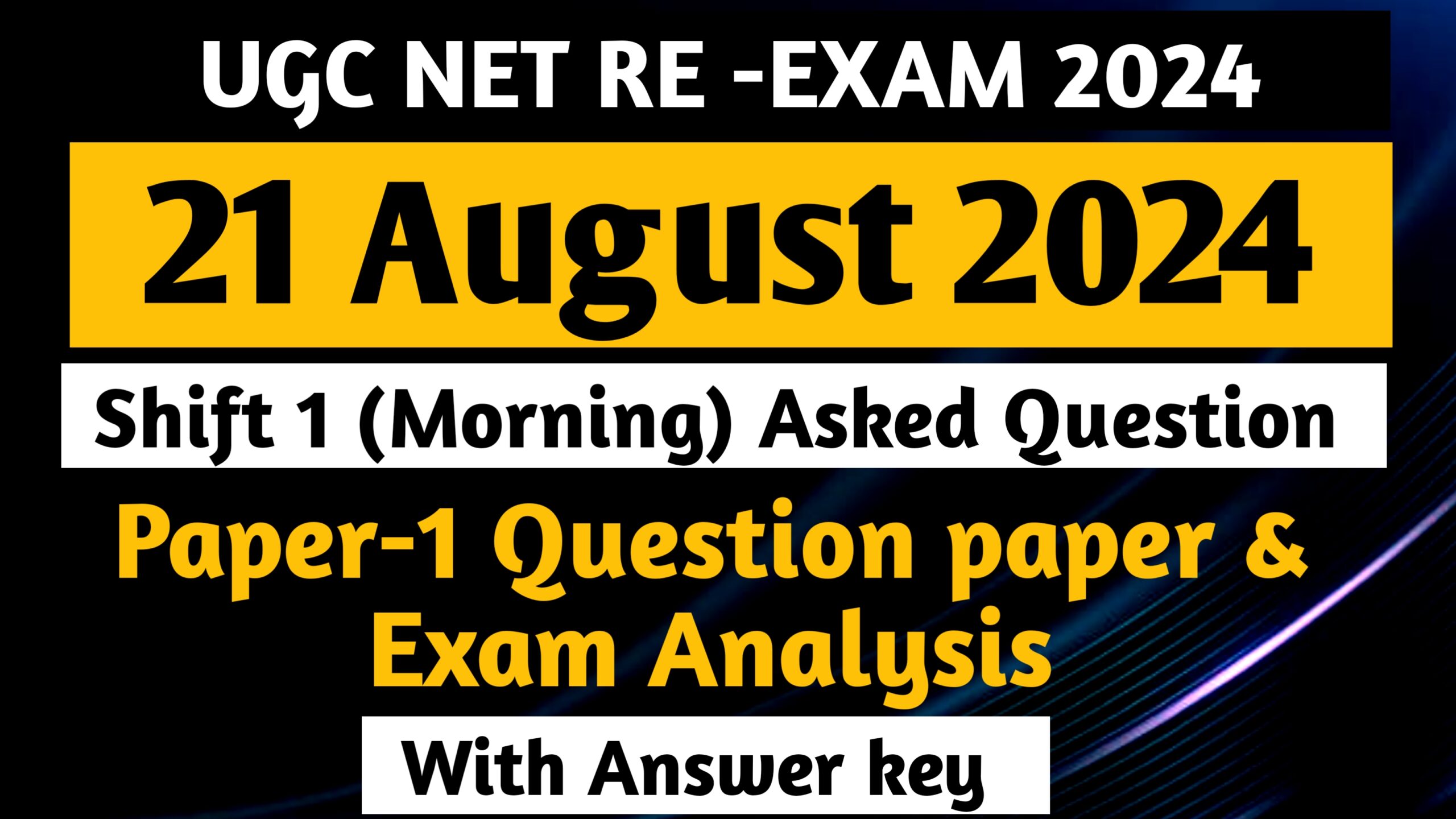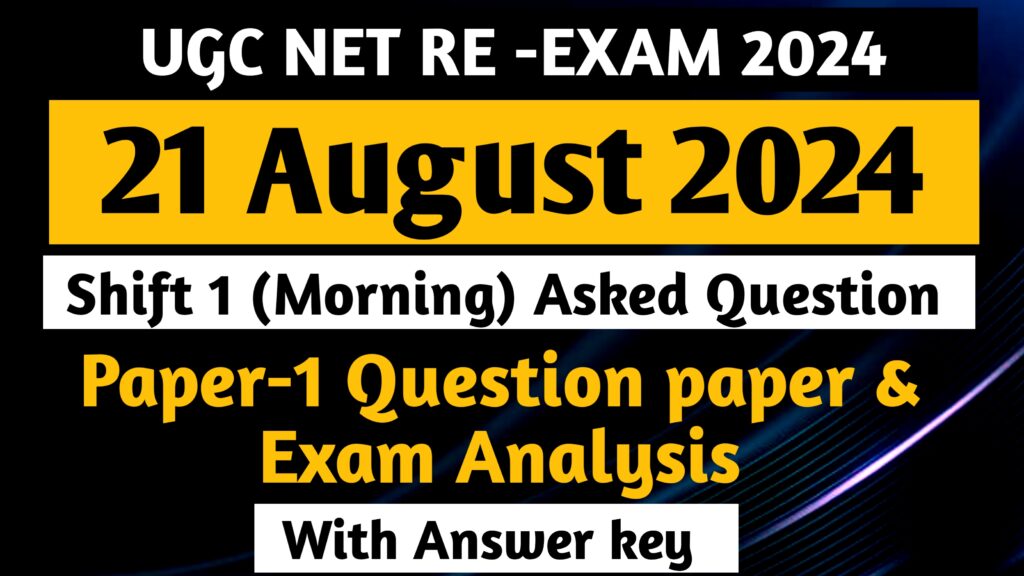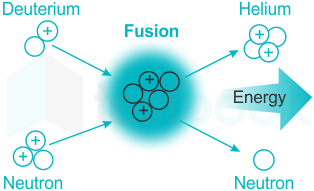
UGC NET 21 AUGUST 2024 Question Paper & Exam Analysis: shift 2 started at 3 a.m and will conclude at 6 p.m on August 21, 2024. The NTA is conducting the UGC NET re-exam from August 21 to September 4, 2024. Check below for the UGC NET 2024 live updates, including the exam day guidelines, student reactions, analysis, questions and answers, expected cutoff, good attempts, and more.

UGC NET 21 AUGUST 2024 Question Paper & Exam Analysis Live Updates: The UGC NET 2024 re-exam will be conducted from August 21 to September 4, 2024, for 83 subjects in computer-based mode. Today is day 1 of the UGC NET June 2024 re-exam. Shift 2 started at 3 p.m. and will conclude at 6 p.m. In Shift 2, exam is conducted for subjects English, Dogri, Spanish, Russian, Persian, Comparative Study of Religions and Hindu studies.
In Shift 1, exams was conducted for subjects such as English, Japanese, Performing Arts (Dance/Drama/Theatre), and Electronic Science. The NTA released the UGC NET 2024 June session admit card for exams that will be conducted on August 21, 22 and 23, 2024. For other dates, the authority will soon release the UGC NET 2024 admit card. Scroll down for the UGC NET 2024 live updates, including the shift-wise analysis, student reactions, good attempts, admit card, city slip, memory-based questions, expected cutoff, etc.
UGC NET Paper Review 2024 Difficulty Level
Based on the candidates feedback, English and teaching aptitude sections were easy. However, maths section was difficult. We have updated the section-wise difficulty level here as the shift 1 has ended successfully.
| Subjects | Difficulty Level |
| Teaching Aptitude | Easy |
| Research Aptitude | Easy |
| Comprehension | Easy |
| Logical Reasoning | Easy |
| Data Interpretation | Moderate |
| Maths | Difficult |
| Communication | Easy |
| Environment | Easy-Moderate |
| People & Development | Easy-Moderate |
| Higher Education | Easy |
| IT | Easy |
UGC NET Exam Analysis 2024: Subject Wise
UGC NET exam is divided into two parts: Paper 1 and Paper 2. Paper 1 consists of 50 questions, while Paper 2 includes 100 questions. In Paper 1, there are 10 sections, with 5 questions from each section, and each question carries a weightage of two marks. There is no negative marking for incorrect answers.
We will update the subject-wise analysis for the re-exam here once we receive feedback from the candidates. In the meantime, you can refer to the UGC NET paper review for June 18, 2024, in the table below.
| Subjects | Good Attempts | Difficulty Level |
| Teaching Aptitude | 2-3 | Easy to Moderate |
| Research Aptitude | 2-3 | Easy |
| Comprehension | 3-4 | Easy to Moderate |
| Logical Reasoning | 3-4 | Easy |
| Data Interpretation | 2-3 | Moderate |
| Maths | 2-3 | Difficult |
| Communication | 2-3 | Easy |
| Environment | 2 | Easy-Moderate |
| People & Development | 2-3 | Easy-Moderate |
| Higher Education | 3-4 | Easy |
| IT | 2-3 | Easy |
UGC NET 21 AUGUST 2024 Today Asked Questions
According to UGC regulations 2018 on plagiarism, level 3 plagiarism refers to similarities
- above 60%
- below 10%
- above 10% to 30%
- above 40% to 60%
Key Points
UGC Regulations 2018 on plagiarism define three levels of plagiarism in research publications:
- Level 0 (Minor Similarities): Up to 10% similarity is considered minor and does not attract any penalty.
- Level 1 (Moderate Similarities): 10% to 40% similarity is considered moderate and the faculty member will be asked to withdraw the manuscript and submit a revised version within a stipulated time period.
- Level 2 (Major Similarities): Above 40% similarity is considered major and the faculty member will be penalized with the denial of one annual increment.
Which of the following is the test to the determine amount of oxygen needed to oxidize all pollution materials?
a) Biological Oxygen Demand
b) Chemical Oxygen Demand
c) Botanical Oxygen Demand
d) Physical Oxygen Demand
Answer: b
Explanation: Chemical Oxygen Demand (COD) is the measure of the amount of oxygen necessary to oxidize all the pollutants present in water. The value of the chemical oxygen demand is much higher as compared to the biological oxygen demand.
What happens when phosphorus, nitrates, and detergents in water lead to an acceleration in the growth of algae?
a) Extinction
b) Eutrophication
c) Increase in the number of fishes
d) Increase in the number of aquatic plants
Answer: b
Explanation: The excessive richness of nutrients (phosphorus, nitrates, and detergents) in a lake or other body of water that leads to acceleration in the growth of algae and the natural aging of the lake is known as eutrophication. Excess algal growth deoxygenates water leading to the death of aquatic life.
Nuclear Reactor:
- It is a device used to initiate and control a self-sustained nuclear chain reaction.
- Nuclear reactors are used at nuclear power plants for electricity generation and in nuclear marine propulsion.
- The heat from nuclear fission is passed to a working fluid (water or gas), which in turn runs through steam turbines.
- These either drive a ship’s propellers or turn electrical generator shafts.
Download UGC NET RE EXAM 2024 ADMIT CARD
Nuclear Fusion:
- Nuclear fusion is the nuclear reaction in which two or more atomic nuclei are combined to form one or more different atomic nuclei and subatomic particles.
- Sun and other stars generate light and heat by nuclear fusion.
- A hydrogen bomb is an immensely powerful bomb whose destructive power comes from the rapid release of energy during the nuclear fusion of isotopes of hydrogen (deuterium and tritium), using an atom bomb as a trigger.

________ is used as a fuel in nuclear reactors.
- Co-60
- U-235
- I-131
- More than one of the above
- None of the above
Nuclear fission: In this process, the nucleus of a heavy atom (such as uranium, plutonium, or thorium), when bombarded with low-energy neutrons, can be split apart into lighter nuclei. When this is done, a tremendous amount of energy is released.
Nuclear Fusion: Fusion means joining lighter nuclei to make a heavier nucleus, most commonly hydrogen or hydrogen isotopes to create helium, such as
- Such nuclear fusion reactions are the source of energy in the Sun and other stars. It takes considerable energy to force the nuclei to fuse. The conditions needed for this process are millions of degrees of temperature and millions of pascals of pressure.
- The three most relevant fissile isotopes are uranium-233, uranium-235, and plutonium-239. When the unstable nuclei of these atoms are hit by a slow-moving neutron, they split, creating two daughter nuclei and two or three more neutrons. These neutrons then go on to split more nuclei. This creates a self-sustaining chain reaction that is controlled in a nuclear reactor, or uncontrolled in a nuclear weapon.
First Open University in India was established in the year
- 1966
- 1985
- 1986
- 1982
In 1982, Dr. B.R. Ambedkar Open University became the first open university to be established in India.
UGC NET JUNE 2024 NOTES ,CLASSES & STUDY MATERIAL
 Key Points
Key Points
- The university originated in 1982 as Andhra Pradesh Open University under the Andhra Pradesh Open University Act, 1982.
- The inauguration was officiated by the President of India.
- In 1991, the university underwent a name change, becoming Dr. B.R. Ambedkar Open University, following the Andhra Pradesh Open University (Amendment) Act, 1991.
- This renaming was in honor of Dr. Bhimrao Ramji Ambedkar, the architect of the Indian Constitution, and it occurred on the centenary of his birth.
Hence, the first open university in India was established in 1982.

UGC NET 21 AUGUST 2024 SHIFT 2 EXAM ANALYSIS
UGC NET 22 AUGUST 2024 QUESTION PAPER & EXAM ANALYSIS SHIFT 2
UGC NET 22 AUGUST 2024 SHIFT 1